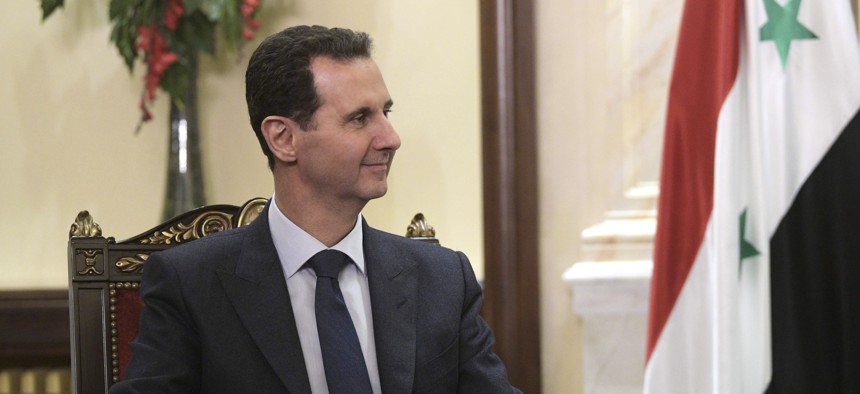
Syrian President Bashar Assad listens to Russian President Vladimir Putin during their meeting in Damascus, Syria, Tuesday, Jan. 7, 2020. Alexei Druzhinin/Sputnik, Kremlin Pool Photo via AP
Trump Says He Wanted To Assassinate Syria’s Assad
The revelation further undermines the president’s assertion that he has stood firmly between the Pentagon and war.
President Trump on Tuesday acknowledged that he wanted to assassinate Syrian president Bashar al-Assad for using chemical weapons in 2017, contradicting his own previous denial of the incident and undercutting a recent assertion that he stops war-hungry Pentagon leaders from starting new wars.
“I would have rather taken him out. I had him all set. Mattis didn't want to do it," Trump said in an interview on “Fox and Friends,” referring to then-Defense Secretary Jim Mattis. "Mattis was against most of that stuff."
Trump’s order was first reported in Bob Woodward’s 2018 book Fear. Woodward reported that the president told Mattis, "Let's [expletive] kill him! Let's go in. Let's kill the [expletive] lot of them.” Trump denied the account two months after the book came out, telling reporters that assassinating Assad “was never contemplated, nor would it be contemplated."
The president’s blithe revelation that he did, in fact, consider killing the Syrian president also appeared to directly contradict his recent claim that “the top people in the Pentagon” don’t like him “because they want to do nothing but fight wars.” Although frequently painted as an isolationist — in part due to his withdrawal from international accords like the Paris Climate accords, the World Health Organization and the Iran nuclear deal — Trump has increased the use of drone warfare tactics in a host of countries, even as he has sought to bring ground troops home. In early 2020, he ordered the killing of the top Iranian general Qassem Soleimani, a move that critics at the time feared would push the United States and Iran to the brink of war.
In some places, Trump has dramatically expanded the United States’ drone campaign. In 2017, he loosened restrictions on lethal operations in Somalia. The Trump administration carried out 64 airstrikes in Somalia in 2019, compared to a high of 19 during the final year of the Obama administration, according to data compiled by New America. Drone strikes also increased dramatically in Yemen during Trump’s first year in office: 130 drone strikes, more than three times the number Obama oversaw in 2017.
Trump has also sought to boost weapons exports, enthusiastically embracing arms sales as both a foreign policy lever and a domestic job creator. Earlier this year, the administration announced it would bypass a 1987 arms control pact to boost weaponized drone sales. It has also repeatedly rebuffed congressional efforts to limit arms sales to Saudi Arabia for use in its bloody campaign in Yemen.
Meanwhile, despite Trump’s repeated campaign-trail claim that he is ending “forever wars “ in the Middle East by bringing troops home from Iraq, Afghanistan, and Syria, more troops have deployed to the region than have returned from it during his first administration — in part because Trump sent roughly 14,000 additional troops to the Persian Gulf region to counter Iranian aggression in 2019. In Afghanistan, Trump has cut troops to 8,500 from a high mark during his presidency of roughly 12,000, with more cuts expected. In Iraq, Trump has ordered the withdrawal of about 2,200 troops. In Syria, troop levels are down to roughly 200 from around 2,000.
Trump also attacked Mattis personally on Tuesday, calling him a “bad leader” and “highly overrated.”
"He was terrible to me, he was a terrible general,” Trump said. He claimed to have defeated ISIS only after Mattis was gone — although Mattis resigned in 2018 only after Trump declared ISIS “defeated” and abruptly ordered the complete withdrawal of U.S. troops from Syria.
"I got rid of ISIS after he was gone. I did a great job on ISIS, 100 percent of the caliphate, got rid of them," Trump said.
Military analysts estimate that there are still thousands of ISIS fighters scattered in pockets across ungoverned areas in Iraq and Syria, and the United States continues military operations against those fighters.
NEXT STORY: US Announces Troop Cut In Iraq
